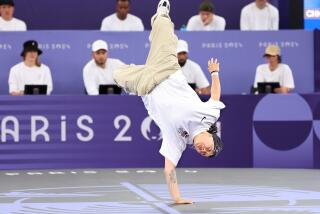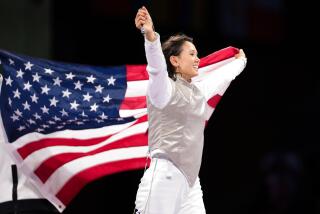Redondo Beach Fencer Leaves Her X on a Sport That Gets Near-0 Support
- Share via
After winning the recent U.S. epee fencing championship, Xandy Brown scurried around Chicago in a frantic search for “USA” insignias that, when applied, could distinguish the sweats her team would wear at a coming international tournament in France.
“All I could find were some iron-on letters at a Woolworth’s,” Brown recalled sheepishly, “and they fell off during the competition.”
The experience seemed emblematic of the treatment many woman fencers receive in this country.
Fencing, a time-honored sport that developed in Europe soon after dueling was outlawed, has three categories: foil, epee and saber. Each uses a weapon of the same name. Men fight in all three categories at the Olympics. Women, due to bureaucratic problems and what many say is lingering chauvinism, can fight only with foils at the Games.
Brown is an epeeist. So, although her national championship would qualify her for the Seoul Olympics beginning Sept. 17, she won’t be flying to Korea.
Whether she could have gotten a plane ticket is an entirely different question.
The U.S. Fencing Assn. functions on $600,000 per year and must fund, according to Executive Director Carla Richards, 25 athletes as they travel around the nation and the world to compete. Richards said Brown’s recent team trip to France cost about $16,000. She also said sweats with USA insignias are normally provided but weren’t at the French tournament because it occurred too soon after the national championships.
Brown, a Redondo Beach resident, recognizes that the USFA’s limited budget cannot cater to every fencer’s whim. She also believes a national champion should not be forced to pay out of her own pocket for her travel expenses and high-priced equipment, which she often does.
“It’s terrible that way,” Brown said. “U.S. fencers get very little support.”
And if they’re woman epeeists such as Brown, securing funding is doubly difficult. Without Olympic status, woman epeeists face an almost unwinnable battle in fighting for sponsors determined to have their names associated with the Games.
The USFA has similar problems. But thankfully, Richards said, the Olympic Committee is trying to help the USFA obtain corporate sponsors.
For woman epeeists, Olympic status seems to be one solution to financial woes. The problem is that women’s foil became an Olympic event only in the last four years, and the first women’s epee world championships will not take place until next year. So, according to Richards, the chances are slim that the France-based International Federation of Fencing will vote women’s epee into the 1992 Games, opting instead for 1996, when many more talented women probably will be competing at the world-class level.
Brown, however, is not sure she can maintain her skills at that level until 1996.
And if she were male, she wouldn’t have to. “If I were a man,” she said, “I would be going to the Olympics this year. That’s very frustrating.”
If she were a man, she would have trekked to Indianapolis with four other men for last year’s Pan American Games. She didn’t. The United States sent only its top two woman epeeists, and Brown was fourth.
“I did what it took to make it to Indianapolis and to Seoul,” she said. “I made the top five in the nation, and I take consolation in knowing that I earned the right to go. But’s it’s not the same as going.”
A look at Brown’s unassuming entry into fencing makes you wonder how she reached such heights in the first place.
When her mother and brother took up recreational fencing in 1978, Brown wasn’t interested. A few months later, Brown, knowing that her mother needed motivational support, replaced her brother when he lost interest. She began taking lessons at Fullerton College in the city where she had gone to high school.
“It was really just a good deed on her part for my sake,” said Priscilla Brown, Xandy’s mother, “and the rest is history.”
Brown, now a schedule analyst at a Redondo Beach space and defense research firm, was playing volleyball and rugby at Cypress College when she began fencing. “Fencing kind of took over,” she said.
Her first year, and every year since, she qualified for national tournaments in foil and epee. Foil is a light-weapon event in which scoring occurs only when the weapon’s tip touches an opponent’s torso. Epeeists swing a heavier sword and use the whole body as a target.
Brown, who received her undergraduate degree in physical education from Cal State Long Beach in 1981, started concentrating on epee last year. She qualified for the finals in every epee event she entered, finished third at the nationals, second at the Sports Festival and fifth in a French tournament--the best of any foreigner.
“I said: ‘Let’s be smart. You should be an epeeist,’ ” she said.
At one time, four members of the Brown family were fencers. That bred a family adage, courtesy of Priscilla Brown. “You’ve heard of ‘The family that prays together stays together?’ ” Priscilla asked. “I came up with, ‘The family that slays together stays together.’ I’m proud of that.”
Priscilla Brown’s dream, at one time, was to outduel her son, her husband and Xandy. “I was always out to kill,” she remembered.
Xandy--it’s short for “Alexandra”--is more concerned with winning. In her view, her victory at the nationals culminated many arduous years she spent developing a mental approach on top of her physical tools.
“I said going in that nothing else mattered except my determination to win,” she said. “I have learned that fencing is from within. As long as I’m concentrating, I’ll do well. Becoming in charge of the mental part is the whole key.
“For me to succeed, it takes a certain attitude. It’s not aggression, but it is a hyper kind of thing. It’s within me. It’s like a rock and I’m condensing into myself.”
She lacked the attitude in France, and finished 28th. But with the help of two coaches who teach in Culver City, Brown expects to get her head together in time for a November world-class tournament in Belgium.
Brown’s coaches supplement her talent in different ways.
Ed Richards of the Westside Fencing Center provides positive reinforcement. Richards, 58, was national foil champion in 1962 and 1963 and began teaching in 1968. He explains the required mental approach this way: “You want your brain to be empty when you fence, not busy. It’s concentration that is required, not thought. Xandy did this at the nationals, and she’ll be all right in international competition if she does the same.”
Al Couturier, Brown’s other coach, runs a fencing school out of Lindberg Park. A Pacific Coast foil medalist in the late 1950s, Couturier--his heritage is French Canadian--has been teaching for 25 years. He believes he’s toughened Brown and helped her learn how to execute the many complex techniques that epee requires.
In August, Brown will officially accept yet another adviser--she’ll marry Mark Robinson, a former co-worker. Brown said her relationship with Robinson lends crucial stability to her fencing career: “Mark is what’s important. He is always there. That allows me to relax and fence better because fencing doesn’t have all the importance it once did.”
Other world-class woman fencers aren’t as fortunate, in Brown’s eyes.
“You can see it in their face. They are very stressed and upset if they don’t do well,” she said. “I make an effort not to be like that. A lot of women decide they want to make the Olympic team, and strange things happen to them. Having seen many of them really unhappy and practically crazy, I won’t allow that to happen to me.”
She combines her confidence with humility. Ten years of dueling with swords haven’t made her a swashbuckler, just a national champion who wants some respect.
Frowning, she said: “By now I should be getting some sweat suits with lettering that stays on. I’m picky, I know, but geez!”
More to Read
Go beyond the scoreboard
Get the latest on L.A.'s teams in the daily Sports Report newsletter.
You may occasionally receive promotional content from the Los Angeles Times.






